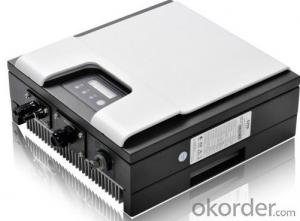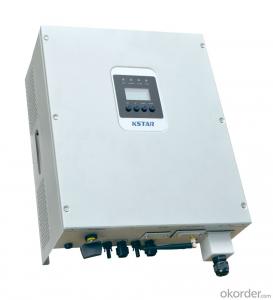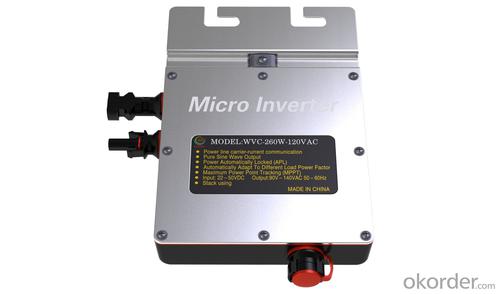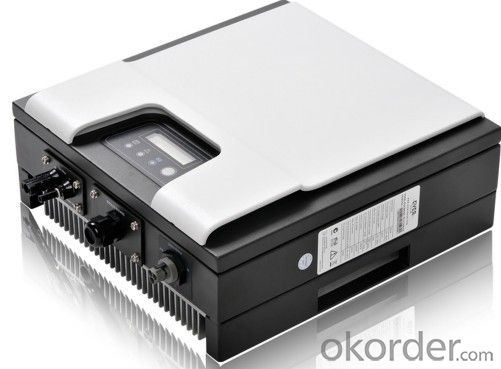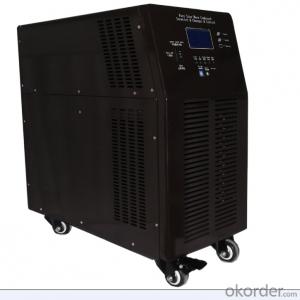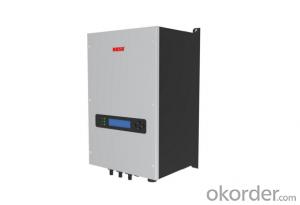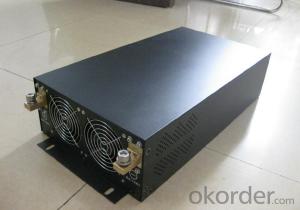Single Phase Inverter Second Generation 2.5k Solar Inverter made in China
- Loading Port:
- Shanghai
- Payment Terms:
- TT OR LC
- Min Order Qty:
- 0 watt
- Supply Capability:
- 10000 watt/month
OKorder Service Pledge
OKorder Financial Service
You Might Also Like
Description of Single Phase Inverter Second Generation 2.5k Solar Inverter
Solar ac power system consists of solar panels, charge controllers, inverter and battery; Solar energy does not include inverter dc power system. Inverter is a kind of power conversion device, inverter by incentives can be divided into self-excited oscillation inverter and separately excited oscillation inverter.
Features of Single Phase Inverter Second Generation 2.5k Solar Inverter
Standard 10 years warranty, 5-15 years optional
Built-in Gprs as option
Built-in Wifi as option
Smaller and lighter, only 9.6kg
High performance DSP for algorithm control
VDE-AR-N 4105 certification
New topology design
Dual MPPT design
Multi-button touch interface
LCD screen visible at night
Have anti-shading function
Advantages of Single Phase Inverter Second Generation 2.5k Solar Inverter
Longer life cycle
Plug and play
Free monitoring through our webportal
Very lower internal temperature
Easy transportation and installation
Faster CPU speed
Adjustable active and reactive power
Maximum conversion effciency up to 97.7%,Euro up to 97.0%
Real-time data readable at night
User friendly operation
Technical Data of Single Phase Inverter Second Generation 2.5k Solar Inverter
Type | Omniksol-2.5k-TL2-S |
Input(DC) | |
Max.PV Power | 2800W |
Max,DC Voltage | 500V |
Nominal DC Voltage | 360V |
Operating MPPT Voltage Range | 120-450V |
MPPT Voltage Range at Nominal Power | 150-450V |
Start up DC Voltage | 150V |
Turn off DC Voltage | 120V |
Max, DC Current | 18A/18A |
Max, Short Cicuit Current for each MPPT | 20A/20A |
Number of MPP trackers | 1 |
Number of DC Connection for each MPPT | 1 |
DC Connection Type | MC4 connector |
Output(AC) | |
Max,AC Apparent Power | 2750VA |
Nominal AC Power (cos phi = 1) | 2500W |
Nominal Grid Voltage | 220V/230V/240V |
Nominal Grid Frequency | 50Hz/60Hz |
Max, AC Current | 12.5A |
Grid Voltage Range* | 185-276V |
Grid Frequency Range* | 45-55Hz/55-65Hz |
Power Factor | 0.9 capacitive... 0.9 inductive |
Total Harmonic Distortion(THD) | <2% |
Feed in Starting Power | 30W |
Night time Power Consumption | <1W |
Standby Consumption | 6W |
AC Connection Type | Plug-in connertor |
Efficiency | |
Max,Efficiency | 97.7% |
Euro Efficiency | 96.9% |
MPPT Efficiency | 99.9% |
Safety and Protection | |
DC Insulation Monitoring | Yes |
DC Switch | Optional |
Residual Current Monitoring Unit (RCMU) | Integrated |
Grid Monitoring with Anti-islanding | Yes |
Protection Class | Ⅰ(According to IEC 62103) |
Overvoltage Category |
PVⅡ/Mains Ⅲ(According to IEC 62109-1)
|
Electricity Fuse Protection | Yes |
Reference Standard | |
Safety Standard | EN 62109, AS/NZS 3100 |
EMC Standard | EN 6100-6-1, EN 6100-6-2, EN 6100-6-3 EN 6100-6-4, EN 6100-3-2, EN 6100-3-3 |
Grid Standard | VDE-AR-N4105. VDE-0126-1-1,G83/1,EN 50438,RD1699,CEI 0-21, AS4777,C10/C11 |
Physical Structure | |
Dimensions | 343x281x150mm |
Weight | 9.9kg |
Environmental Protection Rating | IP 65 (According to IEC 60529) |
Cooling Concept | Internal fan convection |
Mounting Information | Wall bracke |
General Data | |
Operating Temperature Range | -25℃ to +60℃(derating above 45℃) |
Relative Humidity | 0% to 98%, no condensation |
Max. Altitude (above sea level) | 2000m |
Noise Type | <40dB |
Isolation Type | Transformerless |
Display | 3 LED ,Backlight, 4x20 Character LCD |
Data Communication | RS485(WiFi, GRPS integrated) |
Computer Communication | USB |
Standard Warranty | 10 Years (5-15 years optional) |
IMages of Single Phase Inverter Second Generation 2.5k Solar Inverter
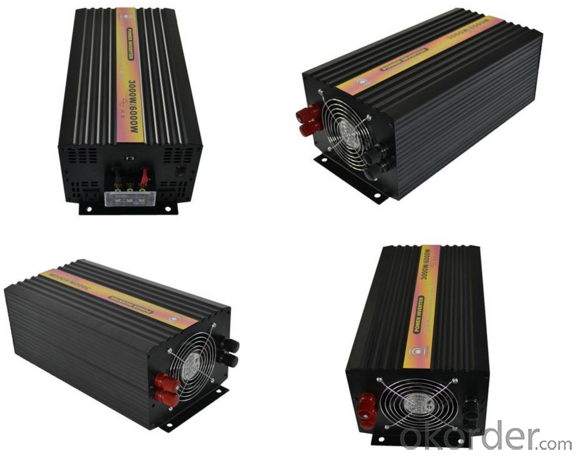
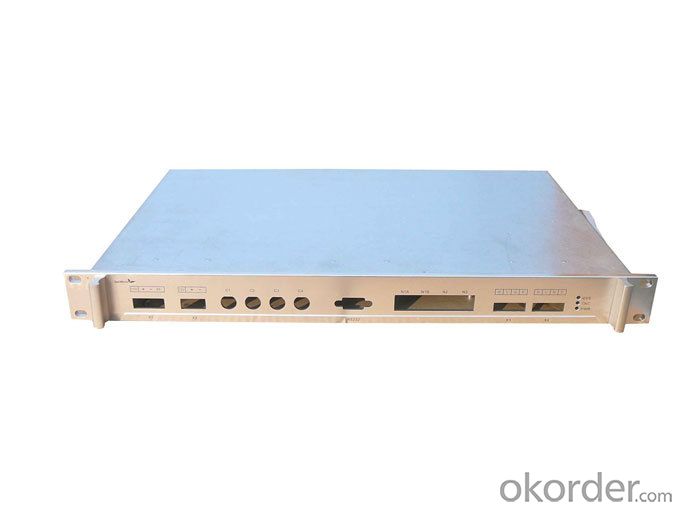

FAQ
Q: Do you have the CE, TUV, UL Certification?
A: We’ve already passed all the tests, and any certificate is available.
Q: Have you ever sold your products to companies in my country?
A: Of course, we have customers in all general PV markets, but I think we should expand our market share along with the market growth.
Q: When did your company set up? You are a new company, how can I believe your quality?
A: We entered into Solar PV industry in 2005, now we have several plants in manufacturing of a-Si and c-Si panels, and our capacity is 220MW per year. Till now we have already passed all the tests by authorized laboratories, e.g. TUV, CE, UL.
Q: Can you help us install the module if we cooperate with you?
A: We haven’t entered into installation sector, but we have the plan in near future.
Q: How do you pack your products?
A: We have rich experience on how to pack the panels to make sure the safety on shipment when it arrives at the destination.
Q: Can you do OEM for us?
A: Yes, we can.
Q: Can we visit your factory?
A: Surely, I will arrange the trip basing on your business schedule.
- Q: Can a solar inverter be used with a solar car charging system?
- Yes, a solar inverter can be used with a solar car charging system. The solar inverter is responsible for converting the direct current (DC) produced by the solar panels into alternating current (AC) that can be used to charge the batteries of a solar car.
- Q: Can a solar inverter be used with solar-powered streetlights?
- Yes, a solar inverter can be used with solar-powered streetlights. The solar inverter converts the direct current (DC) generated by the solar panels into alternating current (AC) that is required to power the streetlights. This enables the solar-powered streetlights to function efficiently and effectively.
- Q: How does a solar inverter affect the overall system performance in different weather conditions?
- A solar inverter plays a crucial role in the overall performance of a solar power system in various weather conditions. It helps optimize the conversion of direct current (DC) generated by solar panels into alternating current (AC) that is used to power homes and businesses. During sunny weather, a high-quality inverter ensures maximum power extraction from the solar panels, resulting in higher energy production and improved system performance. In contrast, in overcast or low-light conditions, a well-designed inverter can still efficiently convert the available solar energy, albeit at a reduced capacity. Moreover, advanced inverters often incorporate technologies like maximum power point tracking (MPPT) to adapt to changing weather conditions, ensuring optimal performance and energy generation regardless of weather variations.
- Q: Can a solar inverter be used with a solar-powered air cooling system?
- Yes, a solar inverter can be used with a solar-powered air cooling system. The solar inverter is responsible for converting the direct current (DC) generated by the solar panels into alternating current (AC) that can be used to power the air cooling system. This allows the system to operate efficiently using solar energy.
- Q: Can a solar inverter be used with different AC voltage systems?
- No, a solar inverter cannot be used with different AC voltage systems. It is designed to convert the DC power generated by solar panels into a specific AC voltage that is compatible with the electrical grid. Using it with a different AC voltage system could lead to compatibility issues and may damage the inverter or the electrical system.
- Q: Can a solar inverter be used with different types of grounding configurations?
- Yes, a solar inverter can be used with different types of grounding configurations. Solar inverters are typically designed to be compatible with various grounding systems, including grounded, ungrounded, or floating configurations. However, it is important to consult the manufacturer's specifications and guidelines to ensure proper installation and operation in accordance with the specific grounding requirements.
- Q: Can a solar inverter be used in a multi-string configuration?
- Yes, a solar inverter can be used in a multi-string configuration. In fact, many solar installations utilize multiple strings of solar panels connected to a single inverter. This allows for increased efficiency, flexibility, and the ability to harvest more energy from the sun.
- Q: Can a solar inverter be monitored remotely?
- Yes, a solar inverter can be monitored remotely. With the help of advanced technologies and internet connectivity, solar inverters can be connected to a monitoring system that allows real-time monitoring and control from a remote location. This remote monitoring feature enables users to track the performance, energy production, and potential issues of their solar inverters without being physically present at the installation site.
- Q: What is the role of frequency support in a solar inverter?
- The role of frequency support in a solar inverter is to ensure that the electricity generated by the solar panels is synchronized with the frequency of the electrical grid. This support is necessary to maintain grid stability and prevent any disruptions caused by fluctuations in frequency. The solar inverter monitors the grid frequency and adjusts the output of the solar panels accordingly, either by increasing or decreasing the power generation, to match the grid's frequency requirements.
- Q: How much maintenance is required for a solar inverter?
- Solar inverters typically require very little maintenance. They are designed to be reliable and durable, requiring minimal attention throughout their lifespan. Regular visual inspections to check for any debris or dust accumulation, as well as ensuring proper ventilation, are recommended. Additionally, monitoring the inverter's performance through software or online platforms can help identify any potential issues. However, in general, solar inverters are known for their low maintenance requirements, making them a reliable choice for renewable energy systems.
Send your message to us
Single Phase Inverter Second Generation 2.5k Solar Inverter made in China
- Loading Port:
- Shanghai
- Payment Terms:
- TT OR LC
- Min Order Qty:
- 0 watt
- Supply Capability:
- 10000 watt/month
OKorder Service Pledge
OKorder Financial Service
Similar products
Hot products
Hot Searches
Related keywords

